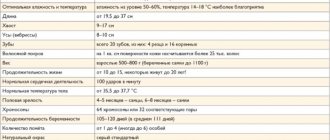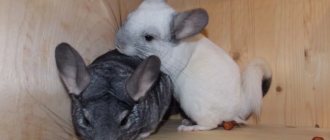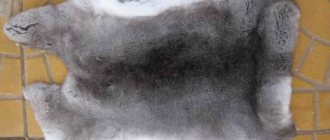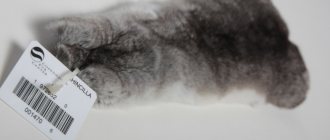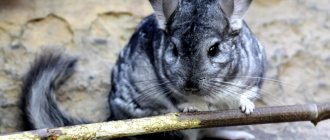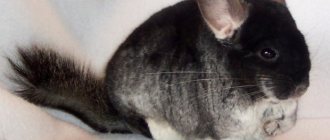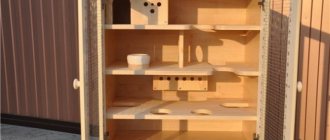The first thing you need to do is to register your activities legally. It is necessary to register an individual entrepreneur (individual entrepreneur) or register your future activity as a personal subsidiary plot. It should be noted that at the moment the legislation does not stipulate any additional documents or licenses for the creation of a chinchilla mini-farm in an apartment, and their further implementation.
The second stage is preparing the room and purchasing the necessary equipment:
- Cage equipment, things to consider:
- The dimensions of the cage for one animal must be at least 60 by 60 cm;
- Hang up the drinking bowl and feeder;
- Put up a hay frame;
- Provide the cage with a bathing suit with high-quality sand;
- Use wood filler for the floor;
- Place a wooden house for shelter;
- Salt and mineral stones must be installed in each cell.
- A room with rodents must be equipped with an air conditioner and a convector, since the most optimal temperature is considered to be no higher than 18-20 degrees, ideally plus 15. At the same time, air flows should not go directly to the cages, because drafts are very destructive for animals.
- Considering the lifestyle, the room should be soundproofed so that the chinchillas have peace and quiet during the daytime, thereby reducing stress, which has a very negative effect on reproduction and childbirth.
- Maintain optimal humidity in the farm room, no higher than 60%.
- Regarding light, there are the following requirements: for every 10 m2, it is necessary to install a 60 W lamp. Direct sunlight should never fall on the rodents' habitat.
The third point, and probably the most important, is the selection of future parents, that is, the purchase of young animals. First of all, you need to decide on the color; one of the most popular is “black corduroy”. You need to purchase young animals from trusted suppliers so that there are no problems along the genetic line or you do not get inbreeding lines that are not capable of fertilization, that is, those obtained from closely related mating.
The fourth, no less important aspect for creating a mini-farm at home is a well-thought-out and well-composed food supply. Feeding should be selected taking into account the structure of the digestive tube and the understanding that this rodent is a pure phytophage (herbivorous animal).
Some farmers try to make feed themselves, but in this case you need to strictly adhere to the recipe and choose high-quality raw materials. For beginners, the most optimal and less labor-intensive option would be to feed them with ready-made concentrated feeds. These are the most nutritious feeds and are easily digestible.
Particular attention should be paid to the nutrition of pregnant individuals; their need for nutrients increases; be sure to increase the amount of vitamins and mineral supplements in their diet. Every animal needs to change its water regularly. The need for water, by the way, increases in pregnant and lactating females.
In chinchillas, the incisors grow continuously and for grinding, it is necessary to provide rodents with blocks for grinding. Do not use oak wood for these purposes; it is rich in tannins and can cause constipation in animals.
Where to start breeding chinchillas as a business at home
In addition to the fact that you need to acquire at least a couple of individuals, you have to complete the following activities:
- Develop a business plan for raising chinchillas at home.
- Prepare a room intended for the farm.
- Purchase the necessary equipment: food, sawdust, cages, toys.
- Place animals on the farm and provide them with a comfortable stay.
- Think over legal ways to receive income from the sale of products: register a business, determine the appropriate tax regime, understand the reporting.
IMPORTANT
: For the cultivation and sale of this type of product, permission from regulatory authorities and licenses are not required.
You need to understand how to breed chinchillas at home. In 1 year, the female produces up to three litters. One litter can have 1-3 cubs. With relatively small capital investments, starting a business requires a large time investment. However, the return on investment is high.
Purchase of equipment
Cells
Cages will be required to house the animals. A number of requirements must be applied to them:
- Optimal sizes are 50/50/60 cm.
- Using fine mesh.
- An area of at least 0.3 sq.m per head.
- Durable material, steel will do.
- Safety.
- Ease of cleaning.
- Many experienced breeders arrange the cages in 2 rows of 6 cages. For this you need 18 sq. m from the area of the room.
Drinkers, feeders, senitsa
A mounted drinker is preferable. If you purchase a floor-mounted one, it must be heavy enough so that the animal cannot turn the vessel over.
The best option is a wire hay barn, from which it is convenient for the rodent to get grass without scattering food on the floor.
For chinchillas, it is recommended to use drinkers with a nipple system. Such a device will provide a round-the-clock supply of clean water to the animals and will not allow them to wet the bedding by splashing the liquid.
Inventory
The chinchilla is an active animal that needs tools for grinding teeth and things that stimulate curiosity and interest. Therefore, it is important to equip your chinchilla’s house with items that will provide the animal with physical activity and serve as a source of entertainment. If you do not provide your chinchilla with toys, she will begin to chew on shelves, houses, and drinking bowls; this will not only bring additional costs for home improvement, but will also cause dental problems. Toys must be made of natural material, without sharp corners.
The following can be used as toys:
- driftwood, thick branches;
- tunnels made of cardboard, wood, plastic;
- hanging toys in the form of wooden balls, bars;
- ladders
Business plan for chinchilla breeding
A business plan involves estimating the upcoming costs of opening a farm. The bulk of the capital will be spent on purchasing the necessary equipment and animals. Rent for premises is excluded from the list of expenses, since chinchillas can be bred at home.
As an example of business profitability, consider a small farm with 10 families of chinchillas.
| expenditures | Cost, rubles |
| Indoor renovation | 20000 |
| Purchase of 10 families (10 males and 30 females) | 240000 |
| Equipment | 80000 |
| Food (for 1 year) | 14000 |
| Paperwork | 5000 |
| Marketing expenses | 15000 |
| Total | 374000 |
With proper care, in the first year of operation the population will increase to 250 individuals. Breeding animals are sold at the age of 3 months. Chinchilla fur reaches marketability at 8 months. Based on this data, the entrepreneur can make an approximate income.
Annual revenue of a chinchilla farm:
| Name of income | Quantity | Price | Amount, rub. |
| Trade in young animals | 70 | 6000 | 420000 |
| Sales of chinchillas to pet stores | 70 | 3000 | 210000 |
| Selling skins | 80 | 5000 | 400000 |
| Total | 1030000 | ||
A chinchilla farm will pay for itself within the first year and will bring its owner good income, which he can use to expand production. As calculations show, the profitability of this business is one of the highest in the field of livestock farming.
Estrus
Fertilization of a chinchilla can only occur during estrus. Therefore, it is during this period that it is necessary to take a particularly close look at the behavior of animals.
The first heat in chinchillas can occur at the age of 5-6 months. With early puberty - at 3-4 months. If it’s late – after a year. The frequency of this physiological process may also differ depending on the individual characteristics of the organism.
On average, chinchillas come into heat once every 30-45 days. But sometimes its frequency is reduced to 20 days. Or, conversely, it increases to 2 months.
Readiness for reproduction can be judged by the following manifestations:
- the female's loop swells, turns pink and opens slightly - the appearance of discharge is noted;
- The chinchilla's nipples become red and protruding;
- The male shows strong interest - he makes calling sounds, does not leave the female, and constantly tries to jump on her.
To properly plan conception, you need to know the main stages of the chinchilla cycle:
- Hunting period . It starts from the moment of estrus and lasts 2-3 days. It is at this stage that ovulation occurs - the most successful moment for conception. Externally, this period is accompanied by the opening of the loop and close communication between partners.
- Braking . Sexual hunting subsides, and the animals gradually return to their usual way of life. At this stage, pregnancy can already be diagnosed.
- Balancing . The female's loop closes completely, and the male almost completely loses interest in her.
Successful conception during estrus is indicated by vaginal plugs emerging from the chinchilla's loop after 1-2 days - the male's seminal fluid dried in the form of thin flagella. Stoppers are necessary to protect future babies from infections.
Care, feeding
Raising chinchillas is not an easy task. Starting from setting up the animals’ place of residence until the day of their sale, a lot of time will pass, during which you will have to make a lot of effort. In particular:
Decide on your diet
What to feed your chinchilla? It's not as difficult as it might seem. Chinchilla food should consist of two parts:
- the first 50% of all feed is dry grass, hay, and hay is a must. It is served with a hay feeder, as the dust from it can spoil the fur of chinchillas. Dry herbs include nettle, dandelion, clover and plantain. Other herbs are also possible, as long as they are not poisonous, but giving such food is also necessary.
- the second 50% of food is dried fruits, special food and tree bark, and if you give your chinchilla dried fruits, then only well-dried ones.
In general, an adult animal eats no more than 30 g of various food per day. Think carefully about the issue of feeding rodents, because the better you feed chinchillas (the better quality), the more expensive their fur will become.
Photo of feeding domestic chinchillas with granulated food
Keep chinchillas clean
A chinchilla should always be clean, just like its cage. If they talk about bathing rodents, they mean cleaning their fur with sand (they don’t need water!). The chinchilla bathes on its own. If there are several animals in the cage, then they can really cope with this task on their own. But when you only have one rodent, it will need your help: combing and trimming matted fur.
Coarse-grained river sand is unsuitable for chinchillas - finely dispersed sand is needed (zeolite is best - it does not cut off the villi). Breeding and keeping an animal clean means:
- change into shavings in the cage - weekly;
- fry the sand, after passing it through a sieve - every month;
- carry out treatment (disinfection of the cell) - once every six months.
Photo of chinchilla and chinchillas
And in order for the animal’s fur to be truly beautiful (marketable), try to hold the chinchilla in your hands as little as possible: if you pick up a rodent, then grab it by the ear or tail. Chinchillas living at home - in apartments - need regular walks. These animals are extremely mobile, so when bred they will not be able to withstand being kept in a cage all the time. Try to let them into the room every day (at least for half an hour). At the same time, keep an eye on them: that’s why they are rodents: they chew everything – furniture, clothes, shoes and even electrical wires.
Risks
Any business involves risks.
In this case, negative factors that can lead to bankruptcy are:
- loss of livestock - in order to preserve animals, you need to follow the rules of care and feeding;
- poor quality of fur - the fur will become worse if you follow your diet and bathe with water;
- competition. It is premature to say that the number of analogue farms exceeds demand, but in some regions there is competition.
Breeding chinchillas can become a promising business. These rodents are highly valued, they are also easy to care for and produce offspring 3 times a year. With a competent approach to business, the project will bring profit.
What do you need to get started?
It is possible to raise fur-bearing animals in small numbers in a private house or apartment. Caring for them will not require much work or a lot of time.
In addition, it should be noted that:
- Chinchillas do not emit unpleasant odors due to the fact that they completely lack sweat and sebaceous glands.
- The fur of such animals is not subject to seasonal molting.
- The animals do not have the habit of biting and scratching.
- Chinchillas chew their own claws without outside help.
This set of facts indicates that keeping chinchillas in an apartment is not accompanied by any special difficulties or inconveniences.
Purchasing the animals themselves
When organizing a chinchilla breeding business, you should understand that both the animals themselves and their magnificent fur can generate income. It is for this reason that every breeder tries to breed pets with incredible and beautiful colors and good quality fur.
If an entrepreneur decides to purchase such animals on the market, in a specialized store or from other breeders, you should understand that the cost of each chinchilla directly depends on the following factors:
- Age of the individual;
- become;
- fur color;
- fur quality;
- health.
A male aged from 3 to 6 months of the most common color will be the cheapest individual to purchase. The exact same female will cost a little more.
In order to organize a fairly profitable business at home, you need to purchase at least 1 dozen females. You don’t have to buy males at all if you find suitable ones locally. If the entrepreneur does not want to use the help of other mini-farms, then he needs to buy 2-3 males.
Cages and equipment for comfortable living of animals
In order for the mini-farm to be provided with everything necessary, the entrepreneur must purchase:
- Automatic drinking bowls for animals and feeders that will provide adequate nutrition for the animals.
- Two convectors providing heating for the home farm. It is best to maintain heat using electrical appliances that dry the air.
- Baths so that the animal can maintain cleanliness.
- lamps , one per 10 squares to maintain the required level of illumination.
- Toys for animals that they can move around the cage.
- Disinfectants
- Mineral stone so that the animal can sharpen its teeth.
- Air conditioner.
In addition to all this, to keep animals you will need cages that meet the following requirements:
- The presence of a container with sand in the cage so that the chinchillas can clean themselves. Moreover, ordinary sand is absolutely not suitable; chinchillas need volcanic fine-grained zeolite.
- The cage should be equipped with drinkers and feeders that can provide a continuous supply of food and water.
- The height of the cage should not be less than 45 cm, otherwise the chinchilla may be injured.
- Each animal must have a cage area of at least 0.3 square meters. m.
On the front wall of each cage there should be drinking bowls, feeders and a door, and on the back wall there should be a bed for animals, the width of which should not be less than 10 cm. The bed should be placed at a height of 25 cm from the bottom of the cage.
A tray with sawdust is installed at the bottom of the cage, which should be replaced at least once every 7 days.
Nutrition
The nutrition of chinchillas is very similar to food for rabbits, but you should take into account the fact that the animals are deprived of direct sunlight, so for their health, the presence of vitamin D in the food should be monitored.
You can compensate for the lack of this vitamin by adding the following to your animals’ food:
- Vegetable mixes
- Bone meal
- Dried fruits
- Fortified hay
- Dried greens
There are no clear recommendations on the amount of weight of food consumed per day due to the fact that individuals of different weights and ages eat differently.
Food for these animals is divided into three main types:
- Concentrated feeds, which, in turn, are divided into the following subgroups: Legumes - beans, peas and lentils;
- Cereals – barley, wheat, corn, millet;
Water for the animal must be purified or at least settled. You should not give tap water or snow to the animal.
Mini farm premises
Fur is the most valuable product that chinchilla breeders sell. Well, in order for it to be of the highest quality, it is very important in what conditions the animal grows.
How to open a chinchilla farm?
To implement a business idea, an entrepreneur must perform the following steps:
- Prepare a room for keeping animals. The cages in which rodents live are placed in 2 rows of 6 pieces. There can be 2 chinchillas in one house. The minimum area of the room should be 18 square meters. m;
- Purchase the necessary equipment. In addition to cages, breeding will require drinking bowls, feeders, toys, bathing containers and sand;
- Install heaters to maintain an optimal temperature of +20 C;
- Buy feed and hay for bedding.
There are additional requirements for keeping chinchillas. According to sanitary standards, the premises should be located away from residential buildings. Do not allow direct sunlight into the room. For lighting it is necessary to use lamps with a power of up to 60 W.
Chinchilla farm
Paperwork
At the initial stage, entrepreneurs can register the farm as a personal subsidiary plot. This will help avoid paying high taxes and reduce investment in starting a business. After production volumes increase, the enterprise must be transferred to individual entrepreneur status.
To carry out legal activities, you will need to obtain permission from the veterinary service.
Note! A license for breeding chinchillas and selling fur is not required.
Purchasing animals
A key factor in business success is the purchase of breeding stock. To open a small farm, it is enough to purchase 10
females and 2 males. It is worth noting that males are valued especially highly, from 6,000 to 9,000 rubles. The animals live for about 15 years, while their reproductive capacity remains unchanged throughout their lives.
Note! It is worth buying your first animals from experienced breeders. They will tell the novice farmer about the nuances of growing chinchillas, and also select high-quality breeding material.
When purchasing animals, you need to pay attention to the following features:
- The animal's fur should be well-groomed and uniform;
- Activity is a sign of a healthy rodent;
- No discharge from the eyes and nose.
If the purpose of the business is selling fur and breeding, it is better to buy chinchillas at the age of 7-8 months.
Feeding
Chinchillas are fed once a day. This is due to the fact that animals are nocturnal and sleep during the day. The main food is pelleted food, herbs, vegetables and fruits. In order to maintain immunity and compensate for the lack of sun and fresh air, the animals are given vitamin complexes. On average, one animal consumes about 50 grams of food per day.
In order to obtain valuable fur, you can also start breeding mink.
Where to sell products?
The entrepreneur must analyze the chinchilla market in advance. Skins and breeding stock are usually sold online. To promote your business, you can create your own website or place advertising on trading platforms.
Note! Feedback from farmers suggests that it is more profitable to work directly with fur factories, without resorting to the help of intermediaries.
Products can be sold at fairs and animal shows. Such events allow breeders to find new sales channels, share experiences with other farmers and purchase quality material for breeding.
Chinchilla fur
Chinchilla at home - feeding a chinchilla
Chinchillas are herbivores, which means they only eat plant foods. Herbivores need food to constantly move through the gastrointestinal tract to avoid health problems. Therefore, the bulk of the diet should be hay, and commercial pellets only add essential nutrients to the diet.
Hay for chinchilla
Mixed grass hay is absolutely essential for your chinchilla's healthy digestion. It helps prevent obesity, dental disease, diarrhea and boredom. Your chinchilla should have unlimited access to quality, mixed-grass hay, and the amount of hay he consumes per day should be twice the size of the chinchilla.
As long as the hay in the cage remains clean and not contaminated with feces or urine, there is no need to change it. Replacing hay can lead to your pet becoming picky about what he eats!
You can also feed alfalfa hay in small quantities to chinchillas who have increased nutritional needs. These include chinchillas under 1 year old, elderly, pregnant and lactating, and convalescent. Healthy chinchillas should only have alfalfa as a treat.
Hay selection
- Forb hay should make up the majority of the diet
- Don't offer the same type of hay all the time; variety is better.
- Different hay packages don't look exactly the same, that's normal.
Use the following types of hay (they can also be mixed): timothy hay, cocksfoot hay, oat hay, and bluegrass hay.
Commercial granules
A balanced commercial kibble food will ensure that your pet gets all the essential vitamins and minerals it needs to stay healthy. The best choice is pellets made from high-quality, high-fiber hay.
Selection of granules
- Choose granules designed for chinchillas.
- Avoid mixtures with nuts, corn, grains and berries, as chinchillas will only choose tasty additives and will not touch healthy foods.
- Always transition your pet slowly from one type of food to another.
Treats and vegetables
Treats are always a great way to bond with your pet. Owners love to treat, and pets love to eat. However, the main purpose of the treat should remain to establish contact between you and the chinchilla. Giving too many treats causes your pet to refuse the main food and not get the nutrients it needs. Contrary to popular belief, chinchillas do not need constant feeding of carrots and sweet treats in the form of yogurt drops and seed sticks. Offer these treats only after your pet has eaten his main food.
Greens serve as a natural and healthy part of the diet. It also contains a lot of moisture. However, greens should be given in limited quantities - no more than the size of your pet's head per day. Red leaf lettuce, romaine, and parsley are good choices. Avoid feeding iceberg lettuce as it is low in nutrients and can cause gastrointestinal distress. Like all new foods, new types of greens should be introduced gradually so as not to cause diarrhea.
Puberty
The reproductive system of chinchillas is ready for conception at 4-5 months. However, experienced breeders do not recommend starting mating at such a young age. The fact is that the final development of the body occurs in fluffies only at one year of age. It is at this age that the female will finally get stronger and will be able to bear and give birth to cubs normally.
There are also certain requirements for the age of males. Only boys over 7 months are allowed to groom chinchillas.
Female nutrition during pregnancy
To get healthy offspring, it is necessary to provide the female with balanced food and slightly increase the portion. Carefully monitor the quality of food so that the chinchilla does not get poisoning or other digestive diseases. Because treating them during pregnancy is doubly more difficult.
Be sure to include in your diet:
- High-quality hay, without debris, rot and mold
- Pelleted feed
- Keep the water clean
- Dilute dry food with fresh vegetables and herbs, but only in small quantities.
- Leaves and branches of trees
- Dried
Remember that you need to be careful with healthy nutrition. You may think that fresh vegetables are the ideal food for your pet, but you will end up with dangerous illnesses such as bloating, constipation or diarrhea. Juicy food is very dangerous for chinchillas, because it causes gas formation in the stomach, and she cannot get rid of them on her own. Therefore, succulent food should make up less than 25% of the daily intake of the total feed.
There are often recommendations on forums that chinchillas in the second phase of pregnancy should be given calcium gluconate. The dose is half a tablet; it helps the development of the fetus and strengthens its bone tissue.
You will find many articles on breeding and caring for chinchillas after birth on our website. Now I will give you links to the most important of them, so that you know all the nuances of chinchilla breeding and what it requires. Not many people are involved in the chinchilla breeding business; competition is quite low. This is due to the fact that the demand for them is not so huge, but there is always a hunt for beautiful colors, because it is almost impossible to find them in pet stores.
Reviews from experienced farmers
Nikolay Petrovich, Moscow region:
When I retired, I was bored without work. It was my grandchildren who came up with the idea to start breeding chinchillas. I started with 30 animals, placed them in the garage, but those who do not have a private farm can raise animals at home, since they do not have dirt or unpleasant odors. Now I am planning to expand, I have already started making new cages, purchased food and agreed with the farm on the supply of breeding females. I rent males.
Irina, Kursk:
I have two years of experience working with chinchillas. My husband and I started with just one family, today we have more than a hundred animals on our farm, and we won’t stop there!
Automation of production and well-established sales of products allow you to manage a large number of animals and have a good income. The plans include entering the international market. The main thing in care is to maintain temperature conditions and not skimp on sand! The animals will do the rest themselves: they will sharpen their teeth and clean their fur coat.


